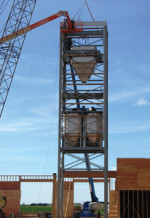Wish List: Bigger, Faster

With almost all cereal production going up in 2007 and no change in the short-term outlook, it appears that fertilizer demand and consumption will once again be strong in 2008. The marked 5% increase in 2006/07 world fertilizer consumption is expected to continue throughout most of the world, including East Asia and North America, which together account for two-thirds of the increase in world consumption, according to the International Fertilizer Industry Association (IFA).
Anticipated Growth
In the U.S., it’s possible that some growers who jumped on the corn bandwagon in 2007 will return to soybeans, a lower-input crop. For the most part, though, cereal crops such as winter wheat and canola will show significant growth. World fertilizer demand is projected to reach 170.3 metric tons of nutrients in 2007/08, an increase of 3.9%. Most of that increase is expected in Latin America at 11.5%, while South Asia will rise by 6.6% and East Asia by 4.1%. The rest of the world is forecast at 1% to 3%, said IFA’s Patrick Heffer and Michel Prud’homme in the organization’s 2007-08 summary report.
However, input prices remain high, translating to a retailer’s need to produce more fertilizer accurately, preventing product loss; additionally, to keep up with the growth and demand, a greater, faster output is needed.
Yargus Manufacturing, Inc. has responded to this with the 16-ton Layco Tapered Vertical Auger Blender. According to Yargus’ Anne Sheehy, marketing, “One can expect approximately 300 ton per hour (tph) or more of blended product.” These outputs, she explains, are “due to engineering the machines with steep cones and 16 Ton Hopper Scales with a 16-inch-wide gate, allowing fast loading and unloading.”
Dealer Opportunities
“We believe concerns people are having about our collective carbon footprint will continue to create business opportunities for fertilizer dealers,” says Waconia Manufacturing’s Gary Burau and Rob Henderson, “especially ones that are willing to invest in new facilities and grow their business.”
One good example is Central Valley Ag facility in Oakland, NE; the 120-acre site with a circle track able to accommodate a 110-car unit train has a 250 tph in-floor reclaim system feeding a blend tower that can load out 200 tph. Both systems were built by Waconia Manufacturing. “It’s really pretty simple,” says Henderson. “The newer, larger capacity plants can receive, store, blend, and discharge material more efficiently. Ultimately, these efficiencies translate into improved profit margins for the dealer.”
Such efficiencies set off a ripple effect, continues Henderson. “Increased storage capacity allows dealers to purchase product when the price is right, assuring ample inventory to meet demand. Increased throughput capacities enable dealers to expand their customer base, because they can deliver fertilizer further away from the plant and make more efficient use of employees rolling stock and lower fuel costs.”
Growing With The Market
Yargus is also excited about a product resulting from extensive research, the new high-capacity Volumetric Rotary Valve, says Sheehy. “The new design has doubled the output of the valve from 1 ton per minute to 2 tons per minute, per valve, based on 60-pound material.
“More retailers seem to want high-capacity machines,” she continued. “There are lots of options with the Volumetric or Declining Weight Blender, and our customers like that.”
Ranco Fertiservice, Inc., has also put out a new DW (Declining Weight) blender to produce high-speed blending with a much higher degree of accuracy, according to the company. The DW blender — a continuous flow system — enables any size load to be blended, from a small spreader to a full trailor load, in minutes.
The DW blend system also offers ease of operation, enabling it to provide what Ranco’s Bruce Hinkeldey calls “accuracies never before seen in the dry fertilizer industry.”
The digital control panel allows the operator to simply enter the amount of each product needed for the blend; the control panel then automatically sets the “most efficient blend time for the desired ratio,” according to Hinkeldey, and continually monitors and adjusts the output of each meter unit. Additionally, the new touch-screen device remotely operates and monitors the digital control panel, permitting quick changes when switching products or time delay sequences.
With differing needs across the globe, the Ranco DW blender is customized for each particular location, and can be expanded with additional bins that can be added at any time. One blender, says Hinkeldey, “can service two separate load-out areas.” Bulk blends and bag blends can be discharged in opposite directions.
New Views, New Visions
Waconia’s Burau and Henderson see the world’s focus on environmental security as a catalyst for more efficient equipment and facilities. “The new systems we’re designing are safer, more environmentally friendly, and require less human contact with materials,” says Henderson. “Accuracy in every area of plant operation has been improved, too; receiving, blending, weighing, inventory tracking, and recordkeeping.
“Add it all up,” he says, “and we like what we see in our crystal ball.”





